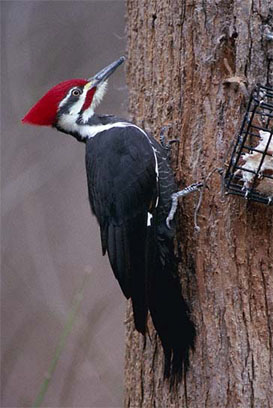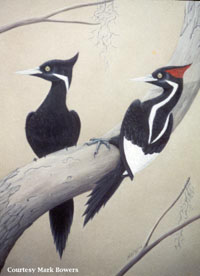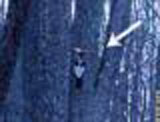Ivory-billed Woodpecker Found in Arkansas
I’ve been watching birds most of my life. I’ve seen a pileated woodpecker just three times; twice when I was 12 years old and living (briefly) in Florida, a third time in my early 20s when visiting my father near Houston. Those sightings were very memorable for me; the pileated woodpecker is a spectacular bird: big as a crow, boldly marked, loud, and boisterous. If a pileated woodpecker were a human, it would be like Muhammed Ali in his prime, only dressed like Liberace. That bird just owns any room it’s in.
One of the things that makes the pileated so nifty, at least for me, is the visual reminder it provides of its close relative, the ivory-billed woodpecker. Even larger and more spectacular than the pileated, the ivory-billed has been thought extinct for decades, its population having crashed in the 19th and early 20th centuries after the southeastern old-growth forests it favored were logged.
There were occasional reports, unconfirmed, of someone seeing one in the backwoods somewhere, but experts always ended up concluding that the sightings actually involved misidentified pileateds. For a while the Cuban subspecies of the ivory-billed was believed to have survived, but then it, too, was downgraded to “presumed extinct.” Today’s best bird-watcher’s field guide, the Sibley Guide to the Birds, doesn’t even bother depicting the ivory-billed.
Well, hold on to your hats, bird-lovers: Ivory-billed woodpecker refound in the USA. There’s also coverage from the Washington Post: Woodpecker thought extinct rediscovered, and from Reuters: Ivory billed woodpecker, feared extinct, isn’t.
I realize that the fact that a tiny remnant population (possibly just a single individual) has managed to survive doesn’t offer much hope; the odds are stacked very much against the species’ actually recovering. Species go extinct; it’s the way of things. But like individual death, extinction is forever, and for someone who cherishes the beauty and wonder of creation, staving it off, if only for a little bit, is reason to celebrate.
Yee ha. The ivory-billed woodpecker lives. That makes my day.
Update: Here are some additional details courtesy the very-much-abuzz birdwatchers’ mailing lists I subscribe to:
For a while CNN’s web site had a small still image taken from a video of the bird (except it actually wasn’t; see below); that image has been removed now, but Google still had a copy of it:
(Later update: Oh, except that image actually is a still from a test video showing a wooden model of the bird that the researchers used for comparison purposes. See the link below for the actual video image.)
From ivorybill.org (!), a video news release that includes the actual footage of the bird: Video news release.
Finally, in PDF form, the article from Science that came out today: Ivory-billed woodpecker (Campephilus principalis) persists in continental North America.




April 28th, 2005 at 10:54 am
Wood…pecker.
Uhhhh huh-huh — you said woodpecker.
I’m surprised that the Pileated ‘peckers are rare. I saw them pretty regularly growing up in the mid-atlantic US.
In any case, I think that their near extinction was due to overhunting for their ivory to make billl scrimshaw. ;)
April 28th, 2005 at 11:09 am
The pileated woodpecker isn’t especially rare; it’s just that I mostly birded in areas that didn’t have them when I was growing up. They were rare for me, in that sense.
January 19th, 2008 at 3:33 pm
video link dead
(obviously: liers!)
June 16th, 2008 at 12:06 pm
Hello,
I am working with Alachua County, Florida to design and produce interpretive signage for a lovely local county park. It is quickly being encroached upon by housing developments and the county has the wisdom to try and educate these folks about the environmental gem that, to them, is just a recreation area. We are developing eight panels to tell the story of the habitats within the park boundaries and how they tie into the larger regional story. The goal of each panel is to give homeowners a better understanding of the importance of being good environmental stewards.
I grabbed a low res copy of the pileated woodpecker above to use on a draft of our Hardwood Hammock panel telling folks about the beautiful hammock and it’s inhabitants in this portion of the park.
We would be very grateful if you would allow us to include your image. If you would be amenable, we would need a 300 dpi or higher resolution jpg or tiff. The panels will be 2’x3’ embedded fiberglass and then installed in the kiosk at the foot of the trail system. I will be happy to provide you with a digital copy of the panel when it’s finalized.
Thanks so much for your consideration,
With best regards,
Beth
Beth Murphy
Working with Karst Environmental Services, Inc.
And Alachua County, Florida
April 14th, 2010 at 8:20 pm
Well, here is a better link for the Luneau video in a higher resolution (woodpecker3…), enjoy
http://www.birds.cornell.edu/ivory/evidence/segments/intro